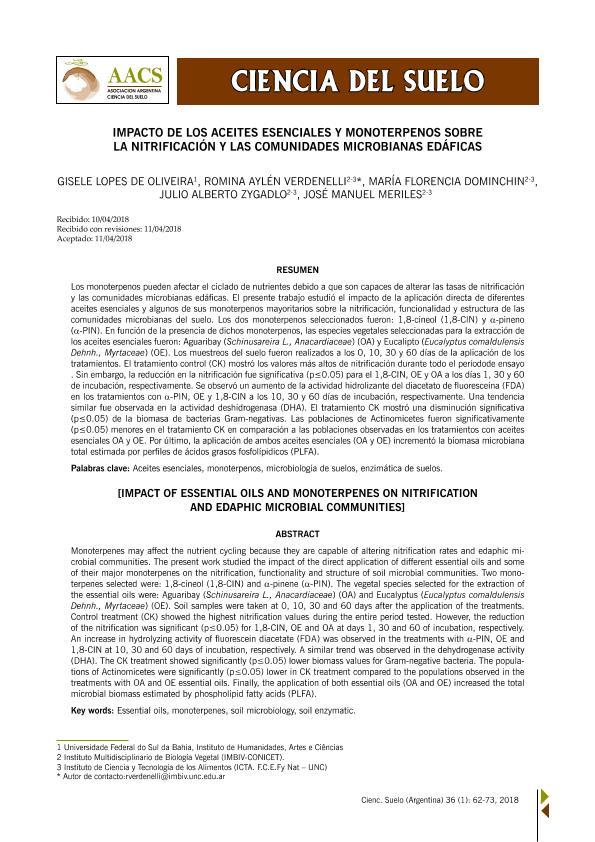Artículo
Monoterpenes may affect the nutrient cycling because they are capable of altering nitrification rates and edaphic microbialcommunities. The present work studied the impact of the direct application of different essential oils and someof their major monoterpenes on the nitrification, functionality and structure of soil microbial communities. Two monoterpenesselected were: 1,8-cineol (1,8-CIN) and α-pinene (α-PIN). The vegetal species selected for the extraction ofthe essential oils were: Aguaribay (Schinusareira L., Anacardiaceae) (OA) and Eucalyptus (Eucalyptus comaldulensisDehnh., Myrtaceae) (OE). Soil samples were taken at 0, 10, 30 and 60 days after the application of the treatments.Control treatment (CK) showed the highest nitrification values during the entire period tested. However, the reductionof the nitrification was significant (p≤0.05) for 1,8-CIN, OE and OA at days 1, 30 and 60 of incubation, respectively.An increase in hydrolyzing activity of fluorescein diacetate (FDA) was observed in the treatments with α-PIN, OE and1,8-CIN at 10, 30 and 60 days of incubation, respectively. A similar trend was observed in the dehydrogenase activity(DHA). The CK treatment showed significantly (p≤0.05) lower biomass values for Gram-negative bacteria. The populationsof Actinomicetes were significantly (p≤0.05) lower in CK treatment compared to the populations observed in thetreatments with OA and OE essential oils. Finally, the application of both essential oils (OA and OE) increased the totalmicrobial biomass estimated by phospholipid fatty acids (PLFA). Monoterpenes may affect the nutrient cycling because they are capable of altering nitrification rates and edaphic microbial communities. The present work studied the impact of the direct application of different essential oils and some of their major monoterpenes on the nitrification, functionality and structure of soil microbial communities. Two monoterpenes selected were: 1,8-cineol (1,8-CIN) and α-pinene (α-PIN). The vegetal species selected for the extraction of the essential oils were: Aguaribay (Schinusareira L., Anacardiaceae) (OA) and Eucalyptus (Eucalyptus comaldulensis Dehnh., Myrtaceae) (OE). Soil samples were taken at 0, 10, 30 and 60 days after the application of the treatments. Control treatment (CK) showed the highest nitrification values during the entire period tested. However, the reduction of the nitrification was significant (p≤0.05) for 1,8-CIN, OE and OA at days 1, 30 and 60 of incubation, respectively. An increase in hydrolyzing activity of fluorescein diacetate (FDA ) was observed in the treatments with α-PIN, OE and 1,8-CIN at 10, 30 and 60 days of incubation, respectively. A similar trend was observed in the dehydrogenase activity (DHA). The CK treatment showed significantly (p≤0.05) lower biomass values for Gram-negative bacteria. The populations of Actinomicetes were significantly (p≤0.05) lower in CK treatment compared to the populations observed in the treatments with OA and OE essential oils. Finally, the application of both essential oils (OA and OE) increased the total microbial biomass estimated by phospholipid fatty acids (PLFA).
Impacto de los aceites esenciales y monoterpenos sobre la nitrificación y las comunidades microbianas edáficas
Título:
Impact of essential oils and monoterpenes on nitrification and edaphic microbial communities
Lopes de Oliveira, Gisele; Verdenelli, Romina Aylen ; Dominchin, Maria Florencia
; Dominchin, Maria Florencia ; Zygadlo, Julio Alberto
; Zygadlo, Julio Alberto ; Meriles, Jose Manuel
; Meriles, Jose Manuel
 ; Dominchin, Maria Florencia
; Dominchin, Maria Florencia ; Zygadlo, Julio Alberto
; Zygadlo, Julio Alberto ; Meriles, Jose Manuel
; Meriles, Jose Manuel
Fecha de publicación:
06/2018
Editorial:
Asociación Argentina de la Ciencia del Suelo
Revista:
Ciencia del Suelo
ISSN:
0326-3169
Idioma:
Español
Tipo de recurso:
Artículo publicado
Clasificación temática:
Resumen
Palabras clave:
ESSENTIAL OILS
,
MONOTERPENES
,
SOIL
,
SOIL ENZYMATIC
Archivos asociados
Licencia
Identificadores
Colecciones
Articulos(IMBIV)
Articulos de INST.MULTIDISCIPL.DE BIOLOGIA VEGETAL (P)
Articulos de INST.MULTIDISCIPL.DE BIOLOGIA VEGETAL (P)
Citación
Lopes de Oliveira, Gisele; Verdenelli, Romina Aylen; Dominchin, Maria Florencia; Zygadlo, Julio Alberto; Meriles, Jose Manuel; Impacto de los aceites esenciales y monoterpenos sobre la nitrificación y las comunidades microbianas edáficas; Asociación Argentina de la Ciencia del Suelo; Ciencia del Suelo; 36; 1; 6-2018; 62-73
Compartir



